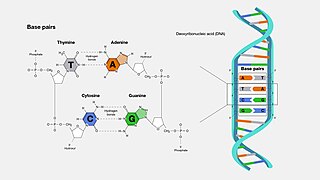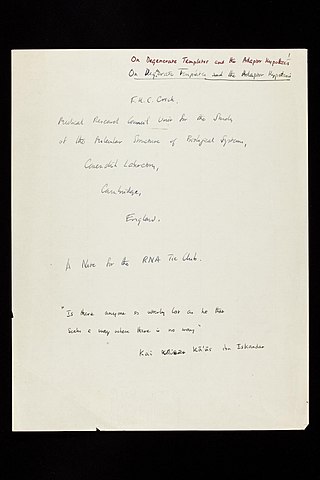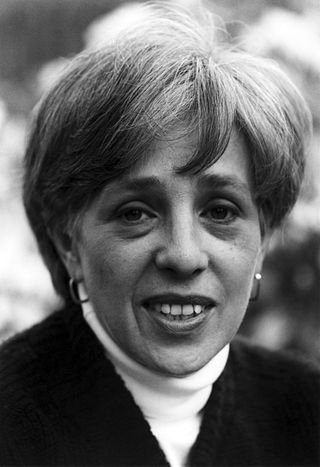Related Research Articles

A base pair (bp) is a fundamental unit of double-stranded nucleic acids consisting of two nucleobases bound to each other by hydrogen bonds. They form the building blocks of the DNA double helix and contribute to the folded structure of both DNA and RNA. Dictated by specific hydrogen bonding patterns, "Watson–Crick" base pairs allow the DNA helix to maintain a regular helical structure that is subtly dependent on its nucleotide sequence. The complementary nature of this based-paired structure provides a redundant copy of the genetic information encoded within each strand of DNA. The regular structure and data redundancy provided by the DNA double helix make DNA well suited to the storage of genetic information, while base-pairing between DNA and incoming nucleotides provides the mechanism through which DNA polymerase replicates DNA and RNA polymerase transcribes DNA into RNA. Many DNA-binding proteins can recognize specific base-pairing patterns that identify particular regulatory regions of genes.
Molecular biology is the branch of biology that seeks to understand the molecular basis of biological activity in and between cells, including biomolecular synthesis, modification, mechanisms, and interactions. The study of chemical and physical structure of biological macromolecules is known as molecular biology.

Nucleic acids are biopolymers, macromolecules, essential to all known forms of life. They are composed of nucleotides, which are the monomer components: a 5-carbon sugar, a phosphate group and a nitrogenous base. The two main classes of nucleic acids are deoxyribonucleic acid (DNA) and ribonucleic acid (RNA). If the sugar is ribose, the polymer is RNA; if the sugar is deoxyribose, a version of ribose, the polymer is DNA.

Har Gobind Khorana was an Indian-American biochemist. While on the faculty of the University of Wisconsin–Madison, he shared the 1968 Nobel Prize for Physiology or Medicine with Marshall W. Nirenberg and Robert W. Holley for research that showed the order of nucleotides in nucleic acids, which carry the genetic code of the cell and control the cell's synthesis of proteins. Khorana and Nirenberg were also awarded the Louisa Gross Horwitz Prize from Columbia University in the same year.

The Nirenberg and Matthaei experiment was a scientific experiment performed in May 1961 by Marshall W. Nirenberg and his post-doctoral fellow, J. Heinrich Matthaei, at the National Institutes of Health (NIH). The experiment deciphered the first of the 64 triplet codons in the genetic code by using nucleic acid homopolymers to translate specific amino acids.
Biomedicine is a branch of medical science that applies biological and physiological principles to clinical practice. Biomedicine stresses standardized, evidence-based treatment validated through biological research, with treatment administered via formally trained doctors, nurses, and other such licensed practitioners.

Temperature gradient gel electrophoresis (TGGE) and denaturing gradient gel electrophoresis (DGGE) are forms of electrophoresis which use either a temperature or chemical gradient to denature the sample as it moves across an acrylamide gel. TGGE and DGGE can be applied to nucleic acids such as DNA and RNA, and proteins. TGGE relies on temperature dependent changes in structure to separate nucleic acids. DGGE separates genes of the same size based on their different denaturing ability which is determined by their base pair sequence. DGGE was the original technique, and TGGE a refinement of it.

Charles Peter DeLisi is an American biomedical scientist and the Metcalf Professor of Science and Engineering at Boston University. He is noted for major contributions to the initiation of the Human Genome Project, for transformative academic leadership, and for research contributions to mathematical and computational immunology, cell biophysics, genomics and protein and nucleic acid structure and function. Recent activities include mathematical finance and climate change.
The history of molecular biology begins in the 1930s with the convergence of various, previously distinct biological and physical disciplines: biochemistry, genetics, microbiology, virology and physics. With the hope of understanding life at its most fundamental level, numerous physicists and chemists also took an interest in what would become molecular biology.

Biomolecular structure is the intricate folded, three-dimensional shape that is formed by a molecule of protein, DNA, or RNA, and that is important to its function. The structure of these molecules may be considered at any of several length scales ranging from the level of individual atoms to the relationships among entire protein subunits. This useful distinction among scales is often expressed as a decomposition of molecular structure into four levels: primary, secondary, tertiary, and quaternary. The scaffold for this multiscale organization of the molecule arises at the secondary level, where the fundamental structural elements are the molecule's various hydrogen bonds. This leads to several recognizable domains of protein structure and nucleic acid structure, including such secondary-structure features as alpha helixes and beta sheets for proteins, and hairpin loops, bulges, and internal loops for nucleic acids. The terms primary, secondary, tertiary, and quaternary structure were introduced by Kaj Ulrik Linderstrøm-Lang in his 1951 Lane Medical Lectures at Stanford University.
Alexander Rich was an American biologist and biophysicist. He was the William Thompson Sedgwick Professor of Biophysics at MIT and Harvard Medical School. Rich earned an A.B. and an M.D. from Harvard University. He was a post-doc of Linus Pauling along with James Watson. During this time he was a member of the RNA Tie Club, a social and discussion group which attacked the question of how DNA encodes proteins. He had over 600 publications to his name.
Stephen C. Harvey is a structural biologist with research interest in nucleic acids, the ribosome, virus structure and high density lipoprotein. He is currently an adjunct professor in the Department of Biochemistry and Biophysics at the University of Pennsylvania and professor emeritus and Georgia Research Alliance eminent scholar emeritus in the School of Biology at the Georgia Institute of Technology, Atlanta, Georgia. Harvey did his undergraduate work at the University of California (Berkeley), where he received his A.B. degree in physics. In the 1960s, he worked as a rocket test engineer on the Apollo program and served with the Peace Corps in Colombia, before entering graduate school in physics at Dartmouth College, where he received his PhD in biophysics in 1971. Before moving to Georgia Tech in 2003, Harvey was professor in the Department of Biochemistry and Molecular Genetics at the University of Alabama at Birmingham (UAB).

The adaptor hypothesis is a theoretical scheme in molecular biology to explain how information encoded in the nucleic acid sequences of messenger RNA (mRNA) is used to specify the amino acids that make up proteins during the process of translation. It was formulated by Francis Crick in 1955 in an informal publication of the RNA Tie Club, and later elaborated in 1957 along with the central dogma of molecular biology and the sequence hypothesis. It was formally published as an article "On protein synthesis" in 1958. The name "adaptor hypothesis" was given by Sydney Brenner.

Maxine Frank Singer is an American molecular biologist and science administrator. She is known for her contributions to solving the genetic code, her role in the ethical and regulatory debates on recombinant DNA techniques, and her leadership of Carnegie Institution of Washington. In 2002, Discover magazine recognized her as one of the 50 most important women in science.
Mark Borodovsky is a Regents' Professor at the Join Wallace H. Coulter Department of Biomedical Engineering of Georgia Institute of Technology and Emory University and Director of the Center for Bioinformatics and Computational Genomics at Georgia Tech. He has also been a Chair of the Department of Bioinformatics at the Moscow Institute of Physics and Technology in Moscow, Russia from 2012 to 2022.
Andrey Nikolayevich Belozersky was a Soviet

Laurence H. Kedes was an American scientist in the fields of gene expression, genomics, and cellular differentiation. His first faculty position was at Stanford University (1970-1989), where he was promoted to full professor in the Department of Medicine and focused on basic molecular biology and gene expression. In 1988, the University of Southern California (USC) recruited Kedes to spearhead a campus-wide initiative to strengthen their molecular biology and genetics research programs. At USC, Kedes conceived and developed the Institute of Genetic Medicine, becoming its founding director (1989-2008) as well as the William Keck Professor (1988-2009) and Chair (1988-2002) of the Department of Biochemistry and Molecular Biology.
Umesh Varshney is an Indian molecular biologist, academician and the head of a laboratory at the Indian Institute of Science, Bengaluru. He is a J. C. Bose National Fellow of the Department of Science and Technology and is known for his studies on protein synthesis and DNA repair in Escherichia coli and Mycobacterium tuberculosis. An elected fellow of the Indian Academy of Sciences, Indian National Science Academy and the National Academy of Sciences (India), he is also a recipient of the National Bioscience Award for Career Development of the Government of India. The Council of Scientific and Industrial Research, awarded him the Shanti Swarup Bhatnagar Prize for Science and Technology, one of the highest Indian science awards, in 2001, and then in 2014 with the G. N. Ramachandran Gold Medal for Excellence in Biological Sciences & Technology for his contributions to biological sciences.

Hanah Margalit is a Professor in the faculty of medicine at the Hebrew University of Jerusalem. Her research combines bioinformatics, computational biology and systems biology, specifically in the fields of gene regulation in bacteria and eukaryotes.

Loren Dean Williams is a biophysicist, biochemist, astrobiologist, and professor in the School of Chemistry and Biochemistry at the Georgia Institute of Technology in Atlanta, Georgia. His research seeks to understand the structural basis for macromolecular reactions, from the role of nucleic acids as targets of chemotherapeutics to the ancestral biochemistry of the ribosome during the origin of life.
References
- ↑ "Roger Wartell". Archived from the original on 22 March 2012. Retrieved 17 April 2011.